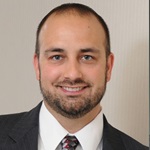Cole T’s Story: Athletic Trainer Was There When He Needed Advice
Click play to watch the video or read video transcript.
When Cole Tebbe said his foot was killing him, his parents sprang into action. The comment caught mom Donna Tebbe’s attention because Cole was not a complainer.
“My husband and I decided that, OK, it’s time to figure out what’s going on, so we got ahold of Corinne,” Donna Tebbe says of Corinne Lyons, an athletic trainer at the UVMC Center for Sports Medicine. As part of her work, Lyons serves as the trainer at the Russia Local Schools, where Cole was a student.
“We went to Corinne because we have some friends who have had an injury within the school system. She reacted right away and was able to get them the treatment they felt was best for their child,” Donna Tebbe says.
Lyons says she saw Cole while at the athletic training room, where he told her his foot had been bothering him and wasn’t getting any better.
She connected Cole and his parents with Jeffrey Rayborn, MD, medical director for the UVMC Center for Sports Medicine, who saw Cole the following morning.
Dr. Rayborn ordered an X-ray. When it came back inconclusive, an MRI was ordered. “It is not uncommon for there to be an early stress fracture that’s not seen on an X-ray, so often further imaging, especially if there’s a high clinical suspicion, needs to be done or else that can progress and become a worse injury,” Dr. Rayborn says. “The last thing we would want would be for Cole to continue to run on a foot that had a fracture and then make it worse, have it crack through further and it would be a much lengthier recovery for him and possibly even need surgical correction.”
Efficient Testing and Results
Donna Tebbe says the Tebbe family was very appreciative that Dr. Rayborn did what he could to have the MRI done the same day when the X-ray came back inconclusive.
The MRI results were available the following day.
“The MRI was positive and we ended up placing him in a Cam walking boot in order to decrease the pressure on his foot to allow that to heal. Had he continued running on it, or even walking on it, it would have taken a lot longer to get better. The boot speeds recovery, and is designed to take the pressure off the foot in the fracture,” Dr. Rayborn says.
To save the Tebbes another trip, Lyons was able to fit Cole for a boot while he was at school practice.
“As an athletic trainer, we are trained with applying braces … and instructing athletes how to properly fit them. I had actually worked with Dr. Rayborn in his office, doing this for his patients years ago when he first started, so it was something I felt comfortable with,” Lyons says.
Safe Return to the Sport
Donna Tebbe says it is obvious from watching Lyons work with the athletes that she loves what she does, and cares about them. “To me, that means a lot … Even though it’s not her son, she did whatever (was needed) to get him healthy and to make him better and stronger than what he was,” she says.
When Cole and his mother returned for Cole’s four-week appointment, Dr. Rayborn told him a couple more weeks in the boot would be needed.
“Had Cole continued running, he definitely could have worsened the injury, it could have cracked through the bone, possibly required surgery to fix, had it not healed properly,” Dr. Rayborn says.
Donna Tebbe was appreciative of the doctor making sure Cole was completely healed before clearing him to run.
“When he says four weeks wasn’t enough, my heart just kind of dropped ‘cause I was looking forward to getting back into track and all of the events,” Cole says. “But, I also realized it was best for me ‘cause that way it wouldn’t reoccur and come back again next year.”
The first primary goal in working with athletes with any injury is that they return safely to their sport, Lyons says.
“Health is Going To Be There For Your Whole Life”
When Cole participated in the pole vault for the first time, his mother admitted she was holding her breath. She says she was thinking, “‘Oh please, don’t let anything happen,’ but he was fine,” Donna Tebbe says. “He hasn’t had any problems with that foot since then.”
Cole says he wasn’t real worried about his foot problem coming back “’cause I felt like I was in great hands with Dr. Rayborn.”
Dr. Rayborn says sports medicine physicians are not there to necessarily make the patients better athletes. “We’re there to make sure they’re doing that safely. We’re there to make sure they can try to stay on the field and do the activities they really want to do,” he says.
Donna Tebbe says the experience shows the importance of the trainers.
“If anyone was to get hurt, you know she’s (Lyons) going to jump right up, she’s gonna give us parents advice on what we need to do. I think it’s very, very important that she continues to be there and that Premier Health continues to support those athletic trainers within the schools,” she says.
Cole added, “Sports are only going to be there for your high school and maybe college careers, but health is going to be there for your whole life.”

Contact Us
Our sports medicine team is ready to help you get back in the game. Call the location nearest you to learn more about sports medicine services in your area.


